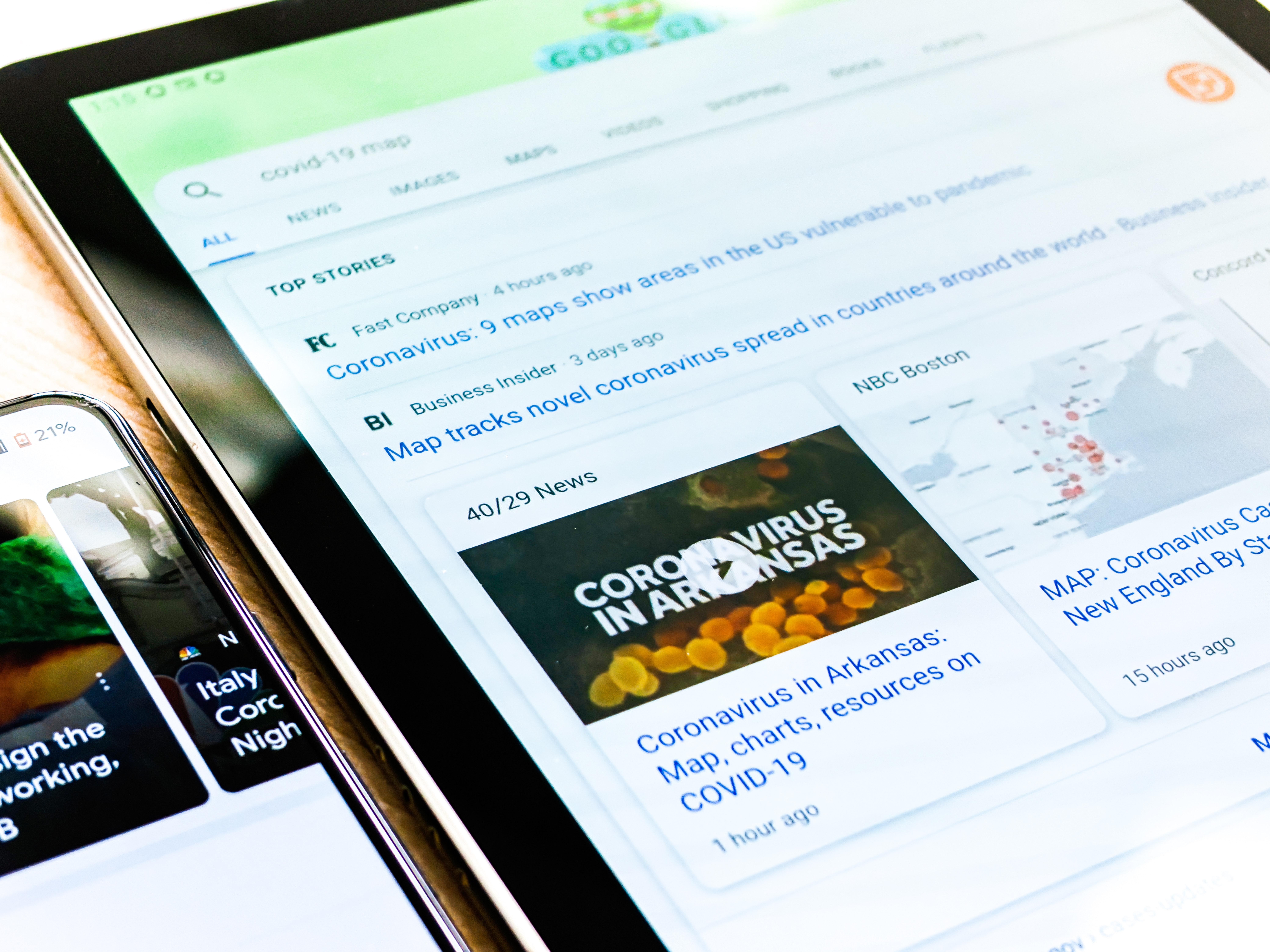Featured
How to Manage Content Marketing in the Midst of Coronavirus
By Casey Nobile on March 20, 2020
3.5 billion. That's the volume of search results for the keyword "coronavirus" in the United States as of March 17, according to SEMRush. And, from February 1 to March 17, Brandwatch data tells us the average daily number of coronavirus-related online mentions in the U.S. has increased over 18X. That's a lot of noise to process, and it begs the question: Where do my customers and my brand fit in?
Marketing's mission hasn't changed—that is, to deliver meaningful information to customers when and where they need it. Except that, right now, our customers' needs, routines, and priorities are much different than they were a month ago, and they're changing daily. Closed businesses; canceled travel, school, and events; self-imposed curfews and quarantines—we're all still reeling over the ripple effects.
And yet somehow, despite all the social distancing, we're more connected than ever by a collective need for perspective and comfort. If you're searching for a meaningful way to respond to this crisis through content, start there—by thinking about how you can offer perspective, about how you can offer comfort.
With that in mind, we're sharing several recommendations and examples of what other brands are doing to help keep your marketing focused as you communicate through this crisis.
Don't Go Dark; Adapt
It's tempting to pause all communication around coronavirus at the risk of getting it wrong, but push yourself and your organization to focus energy on constructive engagement. Likewise, if you're pausing activity until the crisis subsides, you could be in for a long wait (and your results will suffer in the meantime). Digital channels are a safe way to communicate and fill gaps in your marketing chain while facilities close and events and travel remain canceled.
It's important to activate all your digital channels, both to maintain business continuity and to make it convenient for your audience to locate information they'll find useful right now.
There are three primary constituencies to keep in balance as you plan your digital outreach:
-
Employees: Excellent external communications start with internal communication. Make sure you're replacing regular team meetings with daily virtual stand-ups to keep your team coordinated and aware of communication plans, policy changes, and resources available to them. Dedicate a specific channel and/or internal task force to field questions about your organization's ongoing COVID-19 response plan. Your employees will be better supported and in a position to relay accurate information to any customers who may contact them.
-
Customers: Maintaining communication with your customer base will be critical to retaining them. At a minimum, they should be clear on your business's response, how your services continue to be impacted, and what accommodations you're making for them. Consider hosting live webinars or virtual chats to convey information in a format that allows customers to ask questions. Alert customers to new or existing online services via social; share blogs, infographics, and videos containing helpful information across digital channels; and point only to products that are relevant and accessible.
-
Community: If your business is affected, so is your local community and the communities surrounding your global facilities. How can you lend a hand at the local level? Think about how you might assist local relief organizations or at least be a reliable conduit of information about services available to each community. You might create a dedicated landing page on your site to share helpful resources and post regularly about relief services via official hashtags on social.
What other brands are doing right:
- L'Oreal China shifted all offline advertising budgets to only online and actually saw its online sales rise in February.
-
Taco Bell reported that during this pandemic they would "redefine what it means to be a social brand." They've pinned a letter from the CEO to the top of their Twitter page, posted videos explaining their approach to food safety, and are pointing all their customers to ordering via Grubhub.
-
San Francisco-based One Medical added COVID-19 screening questions to its virtual care app and keeps a COVID-19 FAQ page on its site up-to-date daily.
Tune Your Voice to Your Customer
Now is not the time for your brand to risk appearing tone-deaf. Put your audience first by remaining attuned to the topics that are top-of-mind for them as we enter each new phase of the pandemic. Stay focused on anticipating and serving those needs, rather than attempting to drive customers in new directions or aggressively pushing products. At this time, Gartner and other research firms recommend focusing on brand-building and pulling back on campaigns driving short-term sales.
Doing online research will give you a better picture of your audience's needs and emotional context. Given how quickly things are evolving, tools like search and social listening can help by providing real-time insight into your audience's behavior patterns. For example, our analysis of recent search data revealed that over the last two weeks, audiences shifted from wanting to understand the origins of the virus and how it's carried, diagnosed, and treated to seeking location-specific updates and credible news.
To know which topics you should target, exercise the Three R's:
-
Research: Use real-time data to identify the topics that are top-of-mind for your audience relative to your industry or frame of reference (the context in which customers view you).
-
- Online mentions and search activity will reveal shifting trends in audience behavior and where dialog is taking place; drilling down into actual conversations online will give you a better sense of the sentiment surrounding those topics.
- Home in on local geographies and specific demographics to better serve the needs of segments who have been impacted differently.
For example, if you're a diaper brand targeting parents, you may find that your target audience is actively seeking information about where to buy diapers, protecting child health, and activities to keep kids learning and entertained in states where schools are closed.
-
Refine: Of the conversations or topics you've identified, focus on those to which you can add value by asking: Do we have the expertise to weigh in on this? Do we have a solution for this existing or emerging problem? Do we have a unique perspective to offer on this topic?
-
Reflect: As you develop actual content ideas, zero in on how you're uniquely positioned to help. Stick to the essential information and make sure you're being clear and informative. If you find yourself forcing your brand's offerings into a conversation or struggling to justify why what you have to say is important, you should probably step back and disengage. These are clear signs you're dabbling in an area where you don't have the right to play.
Perform this exercise weekly or bi-weekly and keep on tracking! Focusing on the here and now for your customers is critical, but equally important is preparing them and your business for a post-pandemic world. It's unlikely that "recovery" will consist of a complete return to business as usual.
What other brands are doing right:
-
Nickelodeon launched a #KidsTogether campaign, using fun content featuring its characters to share advice to keep kids active and healthy while schools and daycare facilities are closed during the crisis.
-
Healthcare technology brand Abbott shared a video about exactly how hydration helps people recover from viruses and embedded it into a blog about how to build your immunity.
-
IBM posted a blog about how to avoid becoming a target for cybercriminals who prey on individuals during times of public crisis.
Focus on Education and Support
To deliver value, your content doesn't have to be splashy, but it does have to be useful. The litmus test is: Does this provide information that's accurate and helpful right now? Going a step further, is it sharing an action plan, or pointing to meaningful guidance? Is it providing mid-term relief (this could even mean entertainment)? Is it helping to prepare your customers for long-term change?
Tailoring your content to today's needs could involve creating net-new assets or resurfacing existing content, as long as that content is highly relevant, accurate, and appropriate.
Here are a few options to consider:
-
A regularly updated page on your site dedicated to your brand's COVID-19 announcements, coverage, or FAQs
-
Individual blog posts providing trustworthy answers to questions your audience is searching for
-
A publicly available chart, tracker, or infographic that synthesizes complex data on the virus and its impacts in a useful way
-
Videos demonstrating how to access your services, how to safely use your products, or how your business is adapting to the public health crisis
-
A newsletter or blog that aggregates useful tips or information from other credible sources
-
Social posts that explain your latest moves or custom offerings you've developed in response to the crisis
-
A live webinar or video chat with company leadership or a panel of experts in your field
Don't forget to audit all of your content to ensure it's pointing to services or products that are relevant to the content and actually available to the customer, as well as describing safe methods for accessing those services or products (if necessary).
What other brands are doing right:
-
HCM solutions provider ADP published a business resiliency fact sheet to help its business partners prepare
-
Bloomberg compiled OECD trade data to create a map of how the spread of coronavirus can effect global supply chains
-
Capital One created a COVID-19 FAQ page to their site to answer questions for impacted customers
Be Trustworthy and Transparent
Against a backdrop of massive uncertainty, it's critical to ensure you communicate clearly and responsibly. As you craft content, that means paying close attention to trustworthiness and transparency.
As much as possible, enlist the leaders in your organization and experts in the field to lend their voices to your content. In times of crisis, people want to know that individuals at the highest levels of the organization are actively involved in crafting solutions, and that your advice comes from a place of deep expertise.
Be rigorous when it comes to these content best practices:
-
Cite credible, expert sources: Share guidance sourced from and/or validated by experts. Name those experts, quote them directly, and back up your claims with reliable supporting evidence. If experts are authoring your content, ensure that you link to a bio that details their professional and/or academic credentials.
-
Present reliable data: If you're in a position to synthesize proprietary data in a way that's useful for your audience, ensure that you share the methodology and/or tools used to derive your findings as well as disclosing any caveats. If you're citing other data sources, ensure that you're linking to the original source and that the data is recent enough to still be relevant.
-
Be transparent: Be ready to communicate clearly about the reasoning behind any advice, policies, or business updates you share. Ensure you're prepared to explain your decisions to both employees and customers, and that you've documented the organizations or institutions whose recommendations you're following.
Now is a time to build bridges with content and help alleviate uncertainty in the best ways you can. For our part, we'll be publishing a series of posts that share our analysis of search and social data to help you quantify and demystify the topics that are top-of-mind for your audience in the age of coronavirus.
And our webinar presenting coronavirus-related search and social data findings: Understanding Your Audience in the Age of Coronavirus.
To stay up to date on our latest content and webinars, subscribe to the Content Standard newsletter.
Featured image attribution: Mike Enerio on Unsplash.

